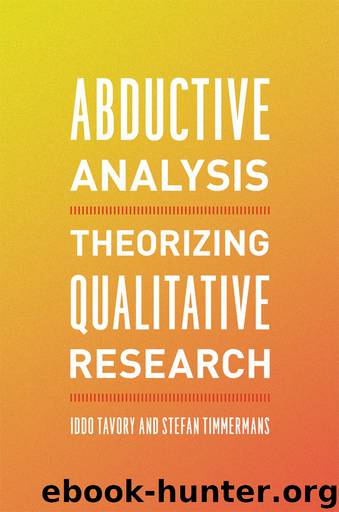Abductive Analysis: Theorizing Qualitative Research by Iddo Tavory & Stefan Timmermans

Author:Iddo Tavory & Stefan Timmermans [Tavory, Iddo]
Language: eng
Format: epub
Publisher: University of Chicago Press
Published: 2014-09-30T00:00:00+00:00
6: CAUSALITY
We have focused on research-driven theory as a variation-based generalization of observations. Multiple forms of variation allow researchers to craft an abductive generalization that fits observations by specifying common grounds of elements in a set, in relationship to a theoretical framework within which they are comparable. The process of double-fitting theory and observations then leads to an articulation of the kind of case we have. This minimalist account of “theory as generalization,” however, misses perhaps the most coveted aspect of theorizing: explaining why observed events occur. A compelling data analysis not only moves from observations to an abstracted description, but also provides readers with a causal explanation of variation.
Moving from variation to causality may seem like an unfortunate step. Causality, as many have observed, is a philosophical minefield.1 As the eighteenth-century philosopher David Hume famously argued, causality is, by definition, invisible. We can never see causality—what we see is ongoing changes in the world, and perhaps we recognize some regularities in our observations over time. Upon these observations we then impose a causal structure. In the language of Immanuel Kant, causality is a category of human reason. Moreover, any causal account ignores much of what is happening, providing an overly neat narrative that highlights only what we see as essential for the story. As John Dewey stressed, causality is a logical “slicing” of a continuously changing and complex world, a temporal stream in which cause and effect as regular occurrences that neatly follow one another in time may be abstracted2 but can never be clearly separated.3
And yet focusing on abduction and meaning-making in action already presumes causality. In its most basic form, abduction asks what we should assume to be true to render a surprising observation “a matter of course,” as Peirce put it, implying a sequencing of events influencing each other. Intimately connected to this idea, the definition of meaning-making as iterative semiotic chains that are built on one another also presumes that one iteration of meaning-making shapes the next. Thus, although it may be true that researchers impute causal relations that are invisible, this is an empirical challenge rather than an intractable philosophical dilemma.
The focus on the unfolding of meaning-making in action makes for a specific approach to causality. Blowing over from medicine, where the randomized clinical trial prevails, experiments have increasingly been elevated as the gold standard of causality, even in the social sciences. This interventionist approach, however, captures only one possible form of causality. Indeed, philosopher of science Julian Reiss notes that various working definitions of causality exist in the social sciences.4 Besides interventionist causality, Reiss distinguishes between counterfactual accounts, regularity accounts, and mechanistic accounts. Reiss then notes that each kind of causality is compatible with particular forms of evidence and disciplinary aims. For example, econometricians tend to treat the notion of causality as synonymous with prediction, and for many “large N” researchers causality is a matter of establishing regularities over time. Our discussion of variation already subsumed rudiments of a regularity-based causal logic, as we look for multiple cases and their variation to buttress our case.
Download
This site does not store any files on its server. We only index and link to content provided by other sites. Please contact the content providers to delete copyright contents if any and email us, we'll remove relevant links or contents immediately.
| Algebra | Calculus |
| Combinatorics | Discrete Mathematics |
| Finite Mathematics | Fractals |
| Functional Analysis | Group Theory |
| Logic | Number Theory |
| Set Theory |
Weapons of Math Destruction by Cathy O'Neil(5036)
Factfulness: Ten Reasons We're Wrong About the World – and Why Things Are Better Than You Think by Hans Rosling(4021)
Factfulness_Ten Reasons We're Wrong About the World_and Why Things Are Better Than You Think by Hans Rosling(2754)
Descartes' Error by Antonio Damasio(2731)
A Mind For Numbers: How to Excel at Math and Science (Even If You Flunked Algebra) by Barbara Oakley(2691)
TCP IP by Todd Lammle(2638)
Applied Predictive Modeling by Max Kuhn & Kjell Johnson(2478)
Fooled by Randomness: The Hidden Role of Chance in Life and in the Markets by Nassim Nicholas Taleb(2413)
The Book of Numbers by Peter Bentley(2404)
The Tyranny of Metrics by Jerry Z. Muller(2401)
The Great Unknown by Marcus du Sautoy(2186)
Once Upon an Algorithm by Martin Erwig(2148)
Easy Algebra Step-by-Step by Sandra Luna McCune(2117)
Practical Guide To Principal Component Methods in R (Multivariate Analysis Book 2) by Alboukadel Kassambara(2092)
Lady Luck by Kristen Ashley(2072)
Police Exams Prep 2018-2019 by Kaplan Test Prep(2032)
Linear Time-Invariant Systems, Behaviors and Modules by Ulrich Oberst & Martin Scheicher & Ingrid Scheicher(1983)
All Things Reconsidered by Bill Thompson III(1960)
Secrets of Creation, Volume 1: The Mystery of the Prime Numbers by Watkins Matthew(1864)
